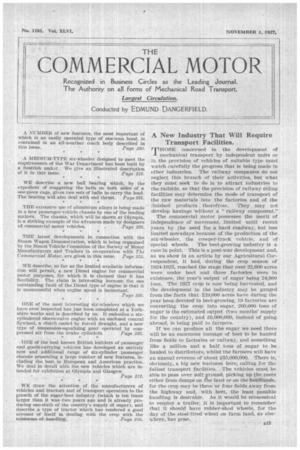:COMMERCT E AL MOTOR
Page 31

If you've noticed an error in this article please click here to report it so we can fix it.
Recognized in Business Circles as the Leading journal. The Authority on all forms of Mechanical Road Transport.
Largest Circulation.
Conducted by EDMUND DANGERFIELD.
A NUMBER of new features, the most important of which is an easily operated type of one-man hood, is contained in an all-weather coach body &scribed in
this issue. Page 3'20.
• A MEDIUM-TYPE six-wheeler designed to meet the requirements of the War Department has been built by a Scottish maker. We give an illustrated description
of it in this issue. Page 318.
WE describe a new ball bearing which, by the expedient of staggering the balls on both sides of a one-piece cage, .gives two sets of balls to carry the load. The bearing will also deal with end thrust. Page .928.
. THE extensive use of aluminium alloys is being made in a new passenger-vehicle chassis by one of the leading makers. The chassis, which will be shown at Olympia, is a striking example of the advances made by designers of, commercial motor vehicles. --Page 626.
* *
THE latest developments in connection with the Steam Wagon Demonstration, which is being organized by the Steam Vehicle COITAJD i I tee of the Society of Motor Manufacturers and Traders in co-operation with The Commercial Motor, are given in this issue. Page 332.
WE describe, so far as the limited available information will permit, a new Diesel engine for commercial motor purposes, for which it is claimed that it has flexibility. The, claim is interesting because the one outstanding fault of the Diesel type of engine is that it is unsuccessful when engine speed is inconstant.
Page 330.
ONE of the most interesting six-wheelers which we have ever inspected has just been completed at a Yorkshire works and is described by us. It embodies a sixeylindered sleeve-valve engine with an encloSed central flywheel, a clutch cooled by forced draught, and a new type of Suspension-equalizing gear operated by com pressed air from the brake cylinders. Page 322.
-ONE of the best known British builders of passenger and goods-carrying vehicles has developed an entirely new and additional range of six-cylinder passenger chassis presenting a large nutnber of new features, including the best. in European and American practice. We deal in detail with the new vehicles which are intended for exhibition at Olympia and Glasgow.
Page 312.
WE draw the attention of the manufacturers of vehicles and tractors and of transport operators to the growth of the sugar-beet industry (which is ten times larger than it was two years ago and is already producing one-sixth of the country's supply of sugar), and describe a type of tractor which has rendered a good account of itself in dealing with the crop with the
riliraM10416 • Page 816.
A New Industry That Will Require Transport Facilities.
rulloSE coneerned in the development of mechanical transport by independent units or in the provision of vehicles of suitable type must watch carefully the progress that is being made in other industries. The railway companies do not neglect this branch of their activities, but what they must seek to do' is to attract industries to the railside, so that the provision of railway siding facilities may determine the mode of transport of the raw materials into the factories and of the finished products therefrom. They may not develop haulage Without a "railway component."
The commercial motor possesses the merit of independence of movement, limited until recent years by the need for a hard roadway, but less limited nowadays because of the production of the six-wheeler, the creeper-track vehicle, and of . special wheels. The beet-growing industry is a case in point. This is a post-war development and, as we show in an article by our Agricultural Correspondent, it had, during the crop season of 1924-1925, reached the stage that over 22,600 acres were under beet and three factories were in existence, the year's output of sugar being 24,000 tons. The 1927 crop is now' being harvested, and the development in the industry may be gauged from the facts that 229,000 acres have during the year been devoted to beet-growing, 19 factories are converting the crop into sugar, 260,000 tons of sugar is the estimated output (two months' supply for the country), and £6,000,000, instead of going abroad, is being paid to farmers.
If we can produce all the sugar we need there will be an enormous tonnage of beet to be hauled from fields to factories or railway, and something like a million and a half tons of sugar to be hauledto distributors, whilst the farmers will have an animal revenue of about £55,000,000. There is, obviously, a big new business here, calling for the fullest transport facilities. The vehicles must. be able to pass over soft ground, picking up the roots either from dumps on the land or On the headlands, for the crop may he three or four fields away from the highway and, with beet, the least possible handling is desirable. As it would be economical to employ a trailer, it is important to remember that it should have rubber-shod wheels, for the day of the steel-tired wheel on farm land, as elsewhere, has gone.




































































































